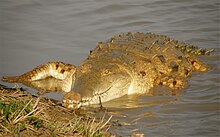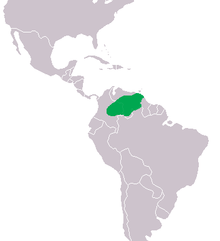| Orinoco crocodile Temporal range: Late Pleistocene–Present,
| |
|---|---|

| |
| Orinoco crocodile in Los Llanos, Venezuela | |
| Scientific classification | |
| Domain: | Eukaryota |
| Kingdom: | Animalia |
| Phylum: | Chordata |
| Class: | Reptilia |
| Clade: | Archosauromorpha |
| Clade: | Archosauriformes |
| Order: | Crocodilia |
| Family: | Crocodylidae |
| Genus: | Crocodylus |
| Species: | C. intermedius
|
| Binomial name | |
| Crocodylus intermedius Graves, 1819
| |

| |
| Range (green) | |
The Orinoco crocodile (Crocodylus intermedius) is a critically endangered crocodile. Its population is very small, and they can only be found in the Orinoco river basin in Venezuela and Colombia. Extensively hunted for their skins in the 19th and 20th centuries, it is one of the most endangered species of crocodiles. It is a very large species of crocodilian; males have been reported up to 6.8 m (22 ft 4 in) in the past, weighing over 900 kg (2,000 lb),[3] but such sizes do not exist today, 5.2 m (17 ft 1 in) being a more widely accepted maximum size. A large male today may attain 4.2 m (13 ft 9 in) in length and can weigh up to 450 kg (1,000 lb), while females are substantially smaller with the largest likely to weigh around 225 kg (496 lb). Sexual dimorphism is not as profound as in other crocodilian species.[citation needed] The coloration is light even in adults.
The ecology of the Orinoco crocodile is poorly documented in the wild, mostly due to its small population. It is thought to have a more piscivorous diet with an opportunistic nature, resulting in generalist predatory behaviour. It is an apex predator and preys on a variety of birds, mammals and reptiles, including caimans on occasion. Its prey base is mostly large predatory fish, challenging the general view by locals complaining about crocodiles hunting local fish to very low numbers. Reproduction takes place in the dry season when the water level is low. It is a hole nester and digs holes in the sand for its clutch of eggs. The females guard the nests and young for several years.[citation needed]
- ^ Rio, J. P. & Mannion, P. D. (2021). "Phylogenetic analysis of a new morphological dataset elucidates the evolutionary history of Crocodylia and resolves the long-standing gharial problem". PeerJ. 9: e12094. doi:10.7717/peerj.12094. PMC 8428266. PMID 34567843.
- ^ a b Balaguera-Reina, S.A.; Espinosa-Blanco, A.; Antelo, R.; Morales-Betancourt, M. & Seijas, A. (2020) [errata version of 2018 assessment]. "Crocodylus intermedius". IUCN Red List of Threatened Species. 2018: e.T5661A181089024. Retrieved 22 January 2022.
- ^ Plotkin, Mark J. (2020). The Amazon: What Everyone Needs to Know. Oxford University Press. p. 76. ISBN 978-0-19-066829-7.
